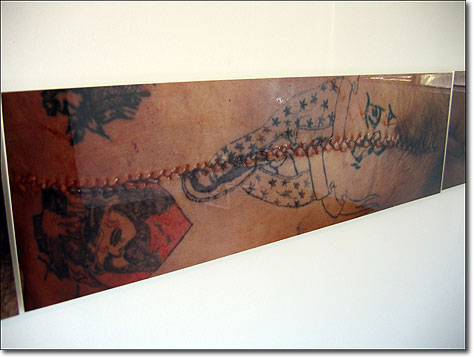Estación Tijuana ,
Aug 27, 2005 - Sep 25, 2005
Tijuana, Mexico
Touch of Evil at Estación Tijuana
by Rubén Bonet
If Tijuana is one of the corners of Mexico, and the most explosive at that, Estación Tijuana is found on the corner of the corner in la colonia Federal. The building’s rear windows open onto the border guard post that stands between Tijuana and San Ysidro. The "street" that it surveys from that vantage point is the roadway leading into Mexico from the United States; a truly unequalled visual performance. In this symantically charged and exuberant site, the Tijuanese artist Marcos Ramirez "Erre" has established his large studio, which doubles as a non-profit independent exhibition space. Here, on August 27th - the same day as inSITE_05 (a rebellious gesture) - the group exhibition Touch of Evil was inaugurated. The title, alluding to the Orson Wells film set in Tijuana, was projected onto one of the walls of the terrace. Few places in the world are charged with so many symbolic connotations as is Tijuana, as a bastard city; a child of vice and gringo crime; and for its veritable border(line) quality, the most crossed - and probably the most controversial - in the world. To avoid this peculiarity when attempting to capture the identity of the conclave would be impossible, to ignore it absurd, given that the border quality is present, not only as a collective idea but as a palpable, everyday reality - forever open to unusual interpretations. In this context, Erre invited six artists, three women and three men, to participate with a "specific" piece (Tijuana as a reality to explore) for this exhibition, where each of those invited not only chose the piece to exhibit but also produced and transported it. This is the kind of invitation where you are a guest but you know that you will pay your own way, and yet you go for the simple pleasure of just being there, to drink with friends and have fun because it’s worth it. The exhibition includes diverse disciplines such as photography, Theresa Margolles; video projection, Carla Herrera-Prats and Andrea Bowers; textual intervention, Daniel Joseph Martinez; industrial graphics, Andrea Bowers; transparency projection (slide shows), Sam Durant; and an installation by Rigo 23. Teresa Margolles’ triptych, Untitled, is composed of a lofty poetic-scatological content of "cadaverous" beauty. It features three color photographic prints of fragments of bodies that have been cut by the pathologist’s knife in autopsy and sewn back up. Positioned one beside the other, the three stitchings come together to form a line that runs from one end of the first image to the last, presenting itself as one and the same wound: a traumatic analogy of the border. In the central image, the incision cuts across a tattoo of the Virgin of Guadalupe distorted by a coarse seam where the drawing doesn’t quite fit, as if it had been badly folded. It is a monstrous metaphor for death that completely does away with beauty - a mockery akin to what this border is to bi-national accords. By using prints in this work, Margolles reveals a change in her methods of representation, which here are characterized by pieces that resist objectification, being merely physical traces of something or someone that used to be. Carla Herrera-Prats exhibits the documentary format video Transactions (17 min), in which she interviews Mexicans hopeful of obtaining postgraduate scholarships in the United States. They explain how their prior prejudices have changed into admiration and respect for a culture that allows them an education that, in Mexico, would not be possible, thus destroying pre-existing clichés. Between the interviews, facts are inserted, such as the number of total scholarships provided by Conacyt and the costs associated with studying for a Master’s degree in American universities, along with other information relevant to a higher education and the abysmal differences that separate the two countries in this regard.
|













